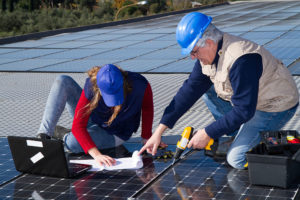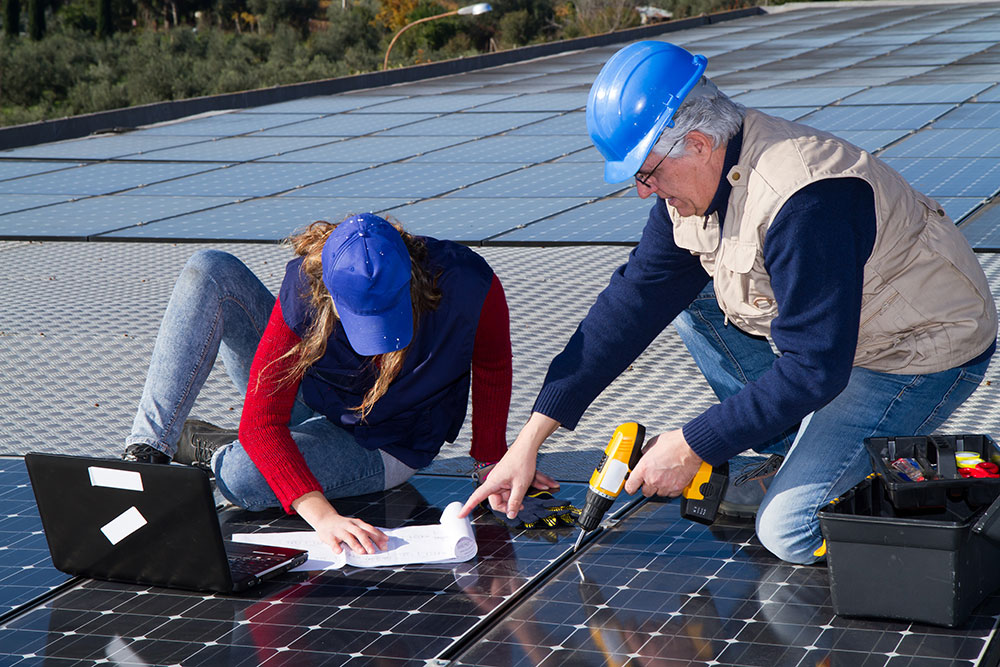Disclaimer: The information on our website is provided for general information purposes only. We make no representations or warranties of any kind, express or implied, about the completeness, accuracy, reliability, suitability or availability with respect to the website or the information contained on our website for any purpose. Any reliance on such information is therefore strictly at your own risk and we are not liable for any damages or losses arising out of or resulting from your reliance on any information contained on our website.
A solar installer, which is also called a PV installer (which stands for photovoltaic), install and maintain solar panels on people’s homes, businesses, or on land. These installers would also be responsible to ground any necessary equipment and ensure safety standards and code are met. Most of the work would be outdoors and often requires workers to be high off the ground.
Watch a Video:
How to Become a Solar Installer
There currently are no degree requirements to become a Solar Panel installer. You may need at least a high school diploma to gain an entry-level position as a solar installer. From there, you would learn how to assemble, install, and maintain solar panel systems on-the-job over a year. If you do not get hired to learn on-the-job, you might find a community college or vocational school that offers courses or even look for an apprenticeship program. Some solar panel installers start as contractors and may get a license through the North American Board of Certified Energy Practitioners, though it is unnecessary to have licensure.
Job Description of a Solar Installer

A solar panel installer would assess a client’s location and then install solar panels to fit the client’s needs. This would include measuring the area and making adjustments so the panels fit. They would also need to install the equipment to meet code, this would include ensuring the wiring is done properly and necessary items are grounded. Since solar panels convert sunlight to electricity, they must also connect the panels to an electrical system.
When not on an installation job, solar installers may be performing maintenance and system checks at various locations, which are mostly outdoors. They could find themselves working alone or as part of a team for larger projects.
Solar Installer Career Video Transcript
We all know that it’s important to take care of the environment around us. Solar photovoltaic installers—or PV installers, as they’re otherwise known—do just that. PV installers are at the forefront of renewable energy solutions as businesses and homeowners strive to consume responsibly. PV installers set up and maintain solar panels. They do specialized work connecting PV, or solar panels, to the power grid, in addition to activating and testing solar-powered systems for quality performance. If you are interested in a career that is technical and labor-intensive, and that also makes a positive impact on the environment, this may be the career for you.
Through their work, PV installers provide environmentally-conscious energy that will last for years to come. PV installers need to be very skilled with their hands, have good balance, and pay close attention to detail. They must be able to lift heavy equipment, parts, and tools. PV installers do most of their work outdoors, often on rooftops. This means that PV installers do face the risk of falling from ladders and roofs, and need to take care to avoid electrical shocks and burns from hot equipment. Training to enter the field lasts from a few days to a few months, and is available at community colleges and trade schools. Candidates with electrician or construction experience are often considered qualified to enter this career with only on-the-job training.
Article Citations
Bureau of Labor Statistics, U.S. Department of Labor, Occupational Outlook Handbook, Solar Photovoltaic Installers.
National Center for O*NET Development. 47-2231.00. O*NET OnLine.
The career video is in the public domain from the U. S. Department of Labor, Employment and Training Administration.


